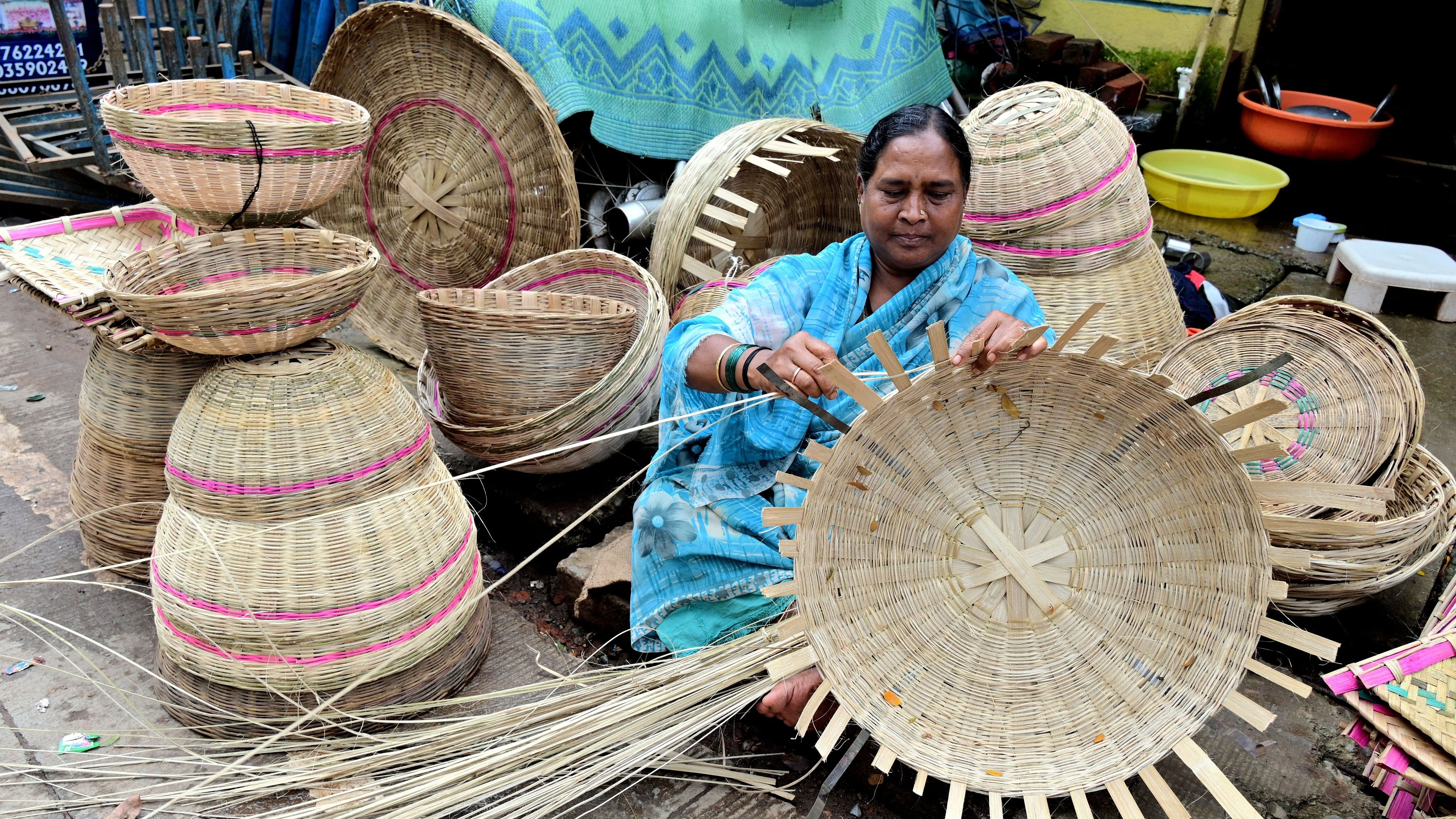
A woman weaves bamboo baskets at Medar Oni in Dharwad; women buy baskets in front of University of Agricultural Sciences, Dharwad.
credit: DH Photos by Govindraj Javali
“I do not want my children to be bamboo artisans like me,” says 43-year-old Savitri Kundgol, a bamboo artisan from Hale Medar Oni in Hubballi. She looks at her daughter and reminds her to study her lessons, while her own fingers continue passing thin bamboo strips through thick bamboo strips arranged in a circular base.
Having learnt the art from her family of bamboo artisans in Byahatti near Hubballi, Savitri married into a family that practised the same profession. She proudly says that bamboo hampers made by her are used by a private television channel to give gifts to guests on a reality show. However, at the same time, she expresses her dismay that bamboo baskets, fans and other decorative items require hard work but fetch little money or recognition.
A few houses down the same street, Vinay Medar returns home for lunch. Vinay, once a bamboo craftsman, now works as a small-time electrician to earn a living. Even though his wife Roopa weaves baskets in her free time to make some extra money for her family, she is also looking for another job so that she can pay the school fees of her children.
Many others on this street of bamboo artisans also do not want their children to continue in their line of work, as they fear that the trade will soon vanish.
Their fear seems real when Mahadev Byahatti, the president of the association of bamboo artisans, takes me through the narrow streets where the artisans live and work. “Earlier, we had nearly 200 families of bamboo artisans here, but now only 100 are left. Of these 100, only 40 to 50 families are active artisans,” he says.
Insufficient support from the government, the availability of cheap plastic articles and the lack of proper marketing facilities have reduced the demand for bamboo products, forcing families to take up other professions, he adds.
The stories of bamboo artisans in other parts of Karnataka are similar. Even to this day, several cities, towns and villages in the state have streets exclusively called ‘Medar Onis’ (meaning street of bamboo artisans), but most people on these streets are no longer practising the craft.
Plastic has replaced almost every product that the bamboo artisans used to traditionally prepare. Many prefer plastics, as they are cheaper and need little to no maintenance.
While the dip in demand is one major challenge that the artisans are facing, they also struggle to sell the products as many of them lack knowledge on how to reach out to a larger customer base.
Geeta Chitagubbi, a professor at University of Agricultural Sciences, Dharwad, also points out that due to the day-to-day drudgery, artisans often face musculoskeletal disorders and pain in the back and neck. Advanced tools and technology, especially for slitting bamboos, can make their work easier, she adds.
Different products
Houses in Burud Galli (street of bamboo artisans) in Belagavi, a city which was earlier known as Venugram (bamboo village), welcome people with a variety of bamboo products.
“We make utility items according to seasons. For instance, during harvest season, we make huge sieves and containers for storing grains. During Holi, we send ‘padligis’ to the Savadatti Yellamma temples,” explains Deepak, an artisan.
However, input costs have increased, he adds. “The price of bamboo shoots has shot up over the years. Around 15 years ago, we would have at least a 30% to 40% profit margin but now, it is just 10%,” he says.
While interior areas like Ballari and Koppal face problems in bamboo supply, areas in and around Malnad have no shortage of bamboo, says Siddappa Bammigatti, another artisan.
“We are skilled, but we do not have a systematic network for marketing. We cannot rely on selling our products in fairs and markets alone,” he adds.
The government provides training and helps artisans participate in some exhibitions. But design trends change and artisans find it difficult to compete with articles like furniture from the northeastern states, says Siddappa.
Even in the tribal pockets of Uttara Kannada, Kodagu and Mysuru, people of the Koraga and Medar communities express similar sentiments.
“One bamboo shoot costs us Rs 300 to Rs 350. Using this, an artisan can prepare six to seven sieves per day. But we sell a pair for Rs 150, or even less sometimes. The demand is also not constant, and we do not have buyers during rainy season,” says Gowramma Medar, an artisan from Kalaburagi district.
Punati Shridhar, chairman of the governing council of the Bamboo Society of India, stresses on the need to conduct research on bamboo cultivation in Karnataka, so that quality bamboo is available locally at affordable costs for artisans. “Currently, even the manufacturing cost of bamboo incense sticks in India is higher, when compared to those we get from China and Thailand,” he says.
Though bamboo artistry in the state seems to be fading out over generations, it could be given a second lease of life if artisans receive enough support.